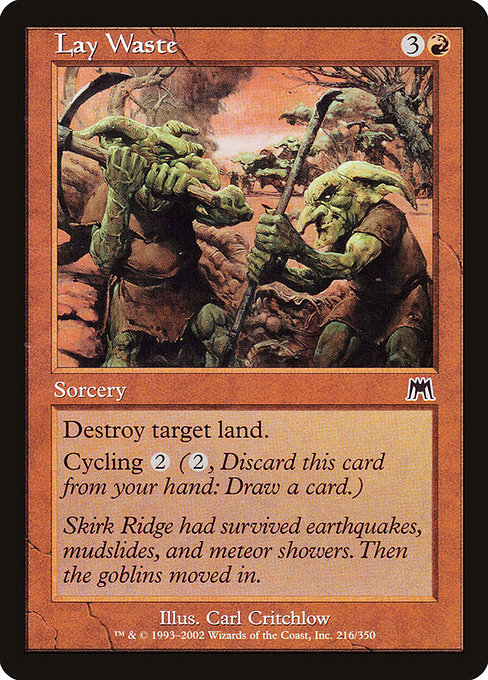
Image courtesy of Scryfall.com
Lay Waste and the Language of Spark-Driven Destruction
Two words can carry a world of meaning in Magic: The Gathering, and Lay Waste is one of those compact, punchy phrases that instantly telegraphs intent. This red sorcery from Onslaught, with its {3}{R} mana cost, is a textbook study in how card-name semantics set the stage for what players expect to happen when cards hit the battlefield or go into the graveyard. The imperative “Lay Waste” isn’t merely a directive to remove a resource; it conjures a vivid mental image of goblin fury tearing through a landscape, a theme that sits squarely in red’s wheelhouse of fast, unforgiving damage. The name tells you the play: target a land, and make it disappear from someone’s mana economy. Fire and ash, not nuance and policy. 🧙♂️🔥
Layering a land destruction effect on a spell with cycling only deepens the semantic pull. The card reads: “Destroy target land. Cycling {2} ({2}, Discard this card: Draw a card.).” The cycling ability turns a straightforward removal spell into a flexible tool that rewards decision-making. You may hold up Lay Waste to punish an opponent who overextends on a streak of nonbasic lands, or you can cycle it away for a fresh draw when your draw step becomes the most valuable land you’re standing on. That duality—the immediate impact of destruction and the optional value of cycling—embeds a kinetic sense of language into the card’s mechanics. The name remains constant, but its usefulness waxes and wanes with the game state, much like a goblin war cry that adapts to the battlefield’s dirt, mud, and rubble. ⚔️🎲
A Red Spell with Red Intentions
In color psychology, red cards lean into speed, aggression, and disruption. Lay Waste fits neatly into that mold. For a common rarity card released in 2002 as part of Onslaught, the combination of a solid mana commitment, a stubbornly reliable destruction effect, and a cycling option creates a design that is approachable yet carryable into more complex archetypes. The Onslaught environment—known for its tribe-focused flavor and sprawling cycle of red and green cards—gives Lay Waste room to breathe as a tempo tool in early drops, or as a strategic gamble when you’re trying to stave off a crowded battlefield. The flavor text, “Skirk Ridge had survived earthquakes, mudslides, and meteor showers. Then the goblins moved in.”, reinforces the sense that goblins thrive in upheaval—turning upheaval into an advantage, one fiery spell at a time. 🔥💎
The card’s artist, Carl Critchlow, brings a tactile feel to the artwork that matches the immediacy of the title. The imagery of a landscape in flux—landscape rent, chaos erupting—amplifies the semantic weight of the name, turning the simple act of destroying a land into a narrative moment. This is where name as story matters: a two-word label that carries a world of context, mood, and strategic expectation. Onslaught’s era—early 2000s—also leans into a tactile, almost tactilely “real” aesthetic, which makes Lay Waste feel like a relic you could reach out and flip through during a game night. 🎨🧭
From Name to Play: Practical Takeaways
- Predictable tempo with a twist: Lay Waste is not just a removal spell; its cycling option lets you pivot when the game demands more cards or when you’re drawing into answers. The name promises impact, and the card delivers it with a swing of an axe-shaped motif. 🪓
- Red's approach to resource denial: Destroying lands is among red’s bluntest tools for depriving opponents of mana access. The name’s decisiveness mirrors the play pattern: identify the most troublesome land and end its reign—then consider the card draw payoff if you cycle. ⚡
- Flavor and mechanics in harmony: The flavor text and the goblin-gone-wild theme reinforce how semantic choices translate into in-game strategies. The name’s urgency echoes the chaos the card creates, not simply the effect it produces. 🧩
- Collectibility context: As a common from the Onslaught era, Lay Waste remains accessible for budget players while still holding nostalgia value for long-time collectors. Current prices are modest, but the foil version often carries a premium due to demand and printed-run variations. 💎
For fans tracing the lineage of card-name semantics, Lay Waste serves as a prime example of how a compact label can anchor a multi-layered gameplay experience. It isn’t just about removing a land; it’s about the aura of decisive, rapid action that red embodies. The card’s cycling option, too, invites a meta-consideration: in what matchups is a guaranteed draw beneficial, and when is the threat of a dead card a cost you’re willing to bear? The dialogue between name, flavor, and function is where MTG design shines, and Lay Waste is a bright beacon of that synergy. 🚀
As you explore this semantic lens, consider how other cards borrow or invert similar patterns. A name like Lay Waste may sit among a chorus of words that imply destruction, but the real magic lies in how the rest of the card’s text—cycling, in this case—transforms the promise into a living, breathing play. And if you’re planning a day of casual play or a polished tournament run, it helps to keep a mental inventory of how names prepare you for the decisions you’ll face on the battlefield. After all, a well-chosen name and a well-timed cycle can be enough to tilt a fragile match in your favor. 🧙♂️🎲
phone case with card holder magsafe polycarbonateMore from our network
- https://blog.rusty-articles.xyz/blog/post/stellar-variability-in-a-blue-white-hot-star-revealed-by-light-curves/
- https://crypto-acolytes.xyz/blog/post/must-have-minecraft-structure-mods-for-epic-builds/
- https://blog.digital-vault.xyz/blog/post/ai-insights-minior-yellow-meteors-place-in-pokemon-meta/
- https://blog.digital-vault.xyz/blog/post/clustering-falkenrath-gorger-and-similar-mtg-cards-with-embeddings/
- https://crypto-acolytes.xyz/blog/post/top-decentralized-launchpads-for-indie-game-developers/